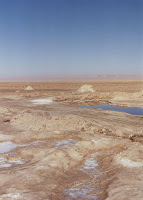In this second instalment of The World of Children of Apollo, we are going to take a brief tour of some of the settlements of Roman North Africa.
 |
| Severan Basilica Leptis Magna |
 |
| The Forum in Sabratha |
Children of Apollo begins in the desert of Cyrenaica province, near settlements of Apollonia and the splendid city of Cyrene , both across the water from Crete . I was not able to travel to these two sites in modern Libya but from my research, they seem splendidly sited in the fertile lands near the Mediterranean . Apollonia served as a port for Cyrene Cyrene itself rivalled Carthage
 |
| Arch of Trajan Colonia of Thamugadi, Numidia |
Moving west, one comes to the great city of Leptis Magna , the home town of Emperor Septimius Severus Leptis Magna Sabratha
 |
| Amphitheater of Thysdrus |
When it comes to Tunisia Algeria
 |
| Cells beneath the Amphitheater floor Thysdrus ('El Jem') |
In northern Tunisia , we traded our 4x4 for an aged Toyota
One of the most interesting sites I visited during our Tunisian safari was Roman Thysdrus (modern El Jem). This settlement today is pretty unassuming except for the massive, extremely well-preserved amphitheatre in the centre. It was a real treat to sit in the seats of the amphitheatre, looking down on the scene of an imagined combat. I could not visit this site and not include a tense scene of gladiatorial combat, as seen by the legionaries on leave. Walking beneath the floor, along the cells where the animals and gladiators were kept, the sounds of those bygone days of barbarism and brutality echoed in my ears. The place definitely has memory. If you ever get the chance to visit El Jem, I would highly recommend it. It must have held some spectacular games in its day.
 |
| Roman Thugga |
Another settlement that bears mentioning here, though it figures more largely in book II of the Eagles and Dragons series, is Thugga. This is a sprawling settlement surrounded by olive groves and green plains. It featured a large theatre, a massive capitol, public baths, a hippodrome and a network of paved streets that you can still walk today. This was a place where I could see my characters walking, interacting with others. It was helped by the fact that we were the only group there the entire time. It was deserted, a Roman ghost town. The mosaics that decorated homes, baths, taverns and brothels are still there, intact and open to the sky. The public latrine is there too, where men and women feeling nature’s call would sit cheek to cheek, literally. I wonder what odd bits of conversation happened there? Would Romans sit there and chat away while they did their business or would they stare at the ground and try not to make eye contact as they made offerings to the Roman infrastructure. Maybe the public latrine was just a place to be avoided, a place where one entered at one’s own risk for fear of robbery or worse. It was just down the street from the brothel (named 'The House of the Cyclops'), so perhaps those patrons were regular users. The imagination ran wild in Thugga!
 |
| Public Latrine Thugga |
The final city we visited was Tunis , the ancient city of Carthage Rome razed Carthage Tunis Carthage Tunis , a must see is the Bardo Museum which contains much of the mosaics and statuary from all of the settlements of that part of the Roman Empire . This is a world class collection with some of the finest mosaics I have ever seen. It was there that the faces of Septimius Severus, Plautianus, Julia Domna and others stared back at me.
 |
| Antonine Baths Carthage |
Leaving Tunisia behind was bitter sweet for I knew that it may be a long while before I would be able to visit such ancient sites on a truly intimate basis again. Haggling in French in the bazaars was fun, as was the experience of seeing camel traders dressed in cloaks that looked a lot like Jawa outfits. I could have done without the bout of fever brought on by my poor choice of soup in Douz, but eating dates from a branch right off the tree was great. Such are the contrasts of travelling but it all adds to the experiences required by writing.


















